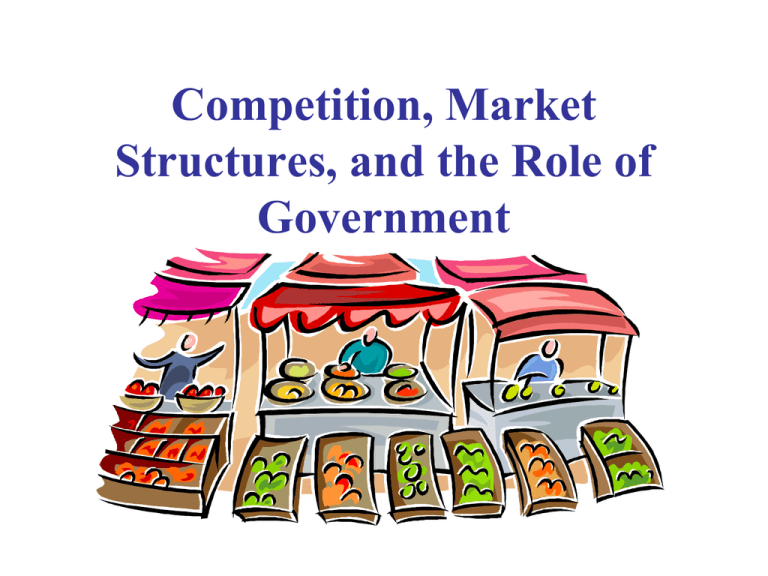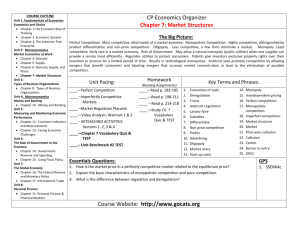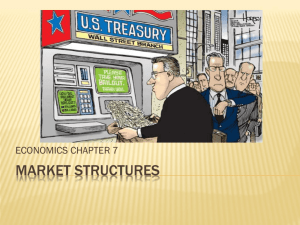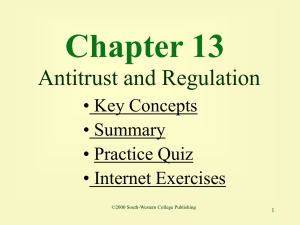Competition, Market Structures, and the Role of Government
advertisement

Competition, Market Structures, and the Role of Government Market Structures • • • • What is the primary aim/goal of businesses? To maximize profits What is competition? Striving against others to reach an objective 4 Types of Market Structure 1. Pure/Perfect Competition – – – Large number of buyers and sellers Identical product Well informed buyers and sellers More Competition Less Competition Pure/Perfecct Competition Many buyer/sellers + QuickTime™ and a TIFF (Uncompressed) decompressor are needed to see this picture. Identical Products Monopolistic Competition • Meets all condition of perfect competition except for identical products. – Product differentiation • Monopolistic competitors use nonprice competition – Advertising, giveaways, or other promotions More Competition Less Competition Monopolistic Competition Gap Levis Lucky Same as pure competition except for product differentiation Monopolistic Competition Are these shampoos/conditioners different? Pantene $14.50 Frederic Fekkai $54 Monopolistic Competition Are these mascaras different? Maybelline Sisley $4 $43 Oligopoly • A few very large sellers dominate the industry • Oligopolists act independently by lowering prices soon after the first seller announces the cut • Collusion: formally agree to set prices • Engage in price wars More Competition Less Competition Oligopoly Ipod Zune Oligopoly Few producers control supply and price Coca-Cola Classic • • • • • • • • Coca-Cola classic Sprite Dasani Barq's Dannon Nestea Rockstar Evian • • • • • • Fanta Fresca Minute Maid Mr. Pibb Powerade Seagrams Ginger Ale & Mixers • TAB Pepsi-co • • • • • • Aquafina Pepsi Mountain Dew Sierra Mist Sobe Lipton Brisk Tea • • • • • MUG Root Beer Slice Gatorade Dole Juice Tropicana Cadbury Schweppes • • • • • 7 Up Canada Dry Clamato Dr Pepper Hawaiian Punch • Mott's • Orangina • Snapple Toyota • Toyota • Scion • Lexus Chrysler • Chrysler • Jeep • Dodge General Motors • • • • • • • • Chevrolet Buick Pontiac GMC Saturn Hummer SAAB Cadillac Monopoly • Only one seller of a particular product • Few monopolies Monopoly • One seller dominates the market with no close substitutes More Competition Less Competition Monopoly • Natural Monopoly efficient production by a single supplier Monopoly • Geographic Monopoly - small town Monopoly 1. Technological Monopoly - new invention – Patent: exclusive right for 17 years Segway Monopoly 1. Technological Monopoly - new invention – Copyright: lifetime + 50 years This telecast is copyrighted by the NFL for the private use of our audience. Any other use of this telecast or of any pictures, descriptions, or accounts of the game without the NFL’s consent, is prohibited. Monopoly 1. Government Monopoly government owned businesses A. Antitrust (anti-monopoly) laws 1. Sherman Act of 1890 2. Clayton Act of 1914 3. Federal Trade Commission Act -- Monopolists tend to produce less and charge more. -- Regulatory Agencies control economic behavior (Dept of Justice, Fed T -- Sherman Act outlawed collusive price fixing and monopolies. -- Strengthened the Sherman Act. Sherman Antitrust Act • 1890 – used in early • Outlaws monopolies 19000’s • First government law to limit monopolies • Gave federal gov’t power to investigate trusts and companies suspected of violating the Act • “Antitrust” really means “competition law” Trusts DEF: A combination of firms or corporations formed by a legal agreement Especially in order to reduce competition Standard Trust – came after Standard Oil Clayton Antitrust Act • 1914 • Strengthened Sherman Act • Prohibit “anticompetitive practices” – Mergers/Acquisitions that lessen competition – One person being a director of competing companies B. Cases 1. Standard Oil case (1911) – broke-up. 2. U.S. Steel case (1920) – ‘rule of reason’ by Supreme Court that unreasonably restrain trade. John D. Rockefell controlled nearly a trade for oil and ga The Supreme Cou used the Sherman Act to break up Standard Oil into 3 Other cases… • In an out-of-court settlement, AT&T divested itself into 22 regional phone-operating companies in 1982. • AT&T’s deal to buy T-Mobile USA for $39 billion is shaping up to be a heated regulatory battle. It would create the nation’s largest cellular carrier. Lawmakers are already denouncing the deal, saying it will reduce competition in an already consolidated industry. Countries with Antitrust Laws shown in red C. Mergers 1. Horizontal 2. Vertical 3. Conglomerate -- Horizontal: merger of two competitors that sell similar products in the same geographic market. Examples are Chase & Chemical Bank, Exxon & Mobile. -- Vertical: firms at different stages of production process. Examples are PepsiCo with Pizza Hut, Taco Bell, and KFC. -- Conglomerate: not horizontal or vertical, different firms in different geographic areas. Effectiveness of Antitrust Laws Types of Mergers Automobiles Blue Jeans Conglomerate Merger Autos B A T U C V E D W X Y Z Glass Horizontal Merger F Blue Jeans Denim Fabric Vertical Merger -- Most Vertical mergers are approved by regulators. Top 10 M&A deals worldwide by value (in mil. USD) from 2000 to 2010: Year Purchaser Purchased Ran k Transaction value (in mil. USD) 1 2000 Fusion: America Online Inc. [23][24] (AOL) Time Warner 164,747 2 2000 Glaxo Wellcome Plc. SmithKline Beecham Plc. 75,961 3 2004 Royal Dutch Petroleum Co. Shell Transport & Trading Co 74,559 4 2006 AT&T Inc. BellSouth Corporation 72,671 5 2001 Comcast Corporation AT&T Broadband & Internet Svcs 72,041 6 2009 Pfizer Inc. Wyeth 68,000 7 2000 Spin-off: Nortel Networks Corporation 8 2002 Pfizer Inc. [25][26] [27] 59,974 Pharmacia Corporation 59,515 Bank One Corp 58,761 9 2004 JP Morgan Chase & Co 10 2009 Technofist Inc. Goldspark IT Solution PVT LTD, Inc 11 2008 Inbev Inc. Anheuser-Busch Companies, Inc N/A 52,000







